Taj Mahal, Uttar Pradesh
Been there recently?
The Taj Mahal is a mausoleum complex in Agra, located in the western part of Uttar Pradesh. The Taj Mahal is one of the most famous landmarks in the world and is widely regarded as the best example of Mughal architecture. It is a fusion of Indian, Persian, and Islamic styles and attracts millions of tourists every year. The Mughal emperor Shah Jahan built the monument as a memorial to his late wife Mumtaz Mahal. It is one of the seven wonders of the world and a UNESCO World Heritage Site, making it a monument of pride for both Agra and India. Its name is thought to have originated in Persian, where “taj” stands for “crown” and “mahal” for “palace,” making it the palace of the crown. Interestingly, the queen it was built in memory of held the name Mumtaz Mahal, which meant the crown of the palace. It’s intriguing how this building appears the same from all four sides except the one that faces the River Yamuna. The walls are decorated with Pietra dura mosaics and marble carvings, and all four entrances have elaborate inscriptions. Some of the most valuable gems and stones ever used were once incorporated into its structure, including lapis-lazuli, cornelian, mother of pearl, agate, and emerald.
Nearby Places to See
Agra Fort
The majestic sandstone fort known as Agra Fort was constructed by the Mughal emperor Akbar as a tribute to the grandeur of the Mughal empire. The fortress is shaped like a crescent, with the River Yamuna flanking its eastern wall and enclosing a magnificent imperial city within its 2.5 kilometres-long enclosure walls. The fort is regarded by many as a masterpiece of engineering, design, and construction. The beautiful Moti Masjid, Diwan-i-Khas (hall of private audience), and Diwan-i-Aam (hall of public audience) are just a few of the many buildings found within its walls. The Agra Fort, also called “Lal Qila,” “Fort Rouge,” or “Qila-i-Akbari,” is a must-see attraction in the city.
The majestic sandstone fort known as Agra Fort was constructed by the Mughal emperor Akbar as a tribute to the grandeur of the Mughal empire. The fortress is shaped like a crescent, with the River Yamuna flanking its eastern wall and enclosing a magnificent imperial city within its 2.5 kilometres-long enclosure walls. The fort is regarded by many as a masterpiece of engineering, design, and construction. The beautiful Moti Masjid, Diwan-i-Khas (hall of private audience), and Diwan-i-Aam (hall of public audience) are just a few of the many buildings found within its walls. The Agra Fort, also called “Lal Qila,” “Fort Rouge,” or “Qila-i-Akbari,” is a must-see attraction in the city.
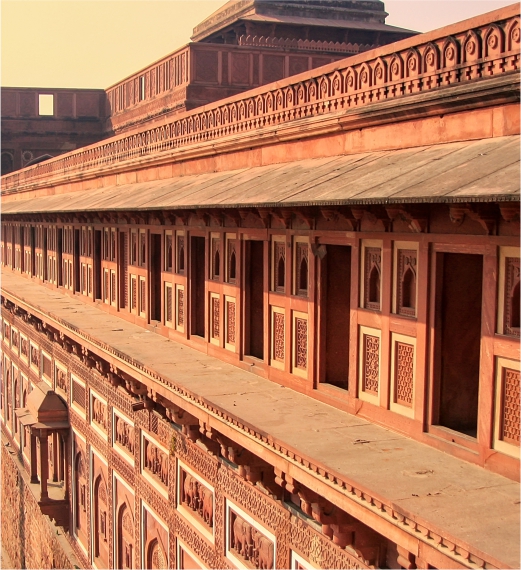
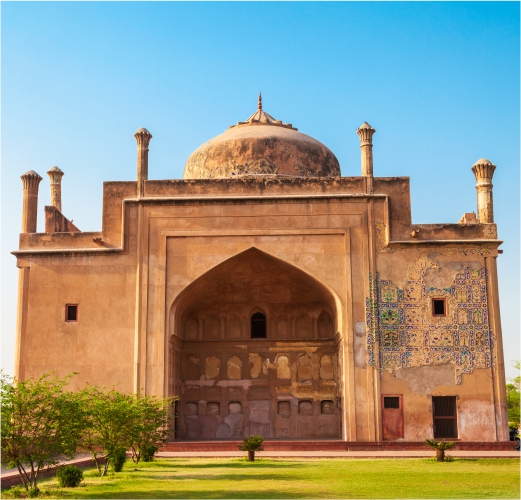
Chini Ka Rauza
Chini-ka-Rauza is a landmark of Indo-Persian architecture and is widely regarded as the first building in India to feature extensive decoration with glazed porcelain tiles. Known for its blue glazed tiles, the monument is set amidst lovely gardens. Porcelain, thought to have been imported from China, was used to make these tiles. They were called “chini mitti” (Chinese clay) at the time. The exterior of the mausoleum has been damaged over the years, but the interior has been well-maintained and features floral designs typical of a signature Persian art style that was adopted by Agra.
Chini-ka-Rauza is a landmark of Indo-Persian architecture and is widely regarded as the first building in India to feature extensive decoration with glazed porcelain tiles. Known for its blue glazed tiles, the monument is set amidst lovely gardens. Porcelain, thought to have been imported from China, was used to make these tiles. They were called “chini mitti” (Chinese clay) at the time. The exterior of the mausoleum has been damaged over the years, but the interior has been well-maintained and features floral designs typical of a signature Persian art style that was adopted by Agra.
Itmad-Ud-Daula
This beautiful marble tomb is dedicated to Mirza Ghias Beg, the father of the Mughal empress Nur Jahan. During his time at the Mughal court, he was accorded the title of Itimad-ud-Daulah (pillar of the state). The structure, which is situated along the Yamuna River, is made entirely of white marble and semi-precious stones. Compared to the red sandstone mausoleums that came before it in the area, the jaalis, or marble lattice screens, give it a softer, more delicate air. This is also the first Mughal structure to have used Pietra dura work, as well as the first tomb to be built on the banks of the River Yamuna.
This beautiful marble tomb is dedicated to Mirza Ghias Beg, the father of the Mughal empress Nur Jahan. During his time at the Mughal court, he was accorded the title of Itimad-ud-Daulah (pillar of the state). The structure, which is situated along the Yamuna River, is made entirely of white marble and semi-precious stones. Compared to the red sandstone mausoleums that came before it in the area, the jaalis, or marble lattice screens, give it a softer, more delicate air. This is also the first Mughal structure to have used Pietra dura work, as well as the first tomb to be built on the banks of the River Yamuna.
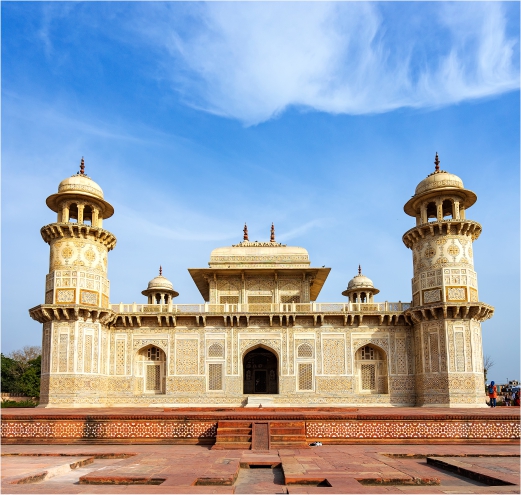
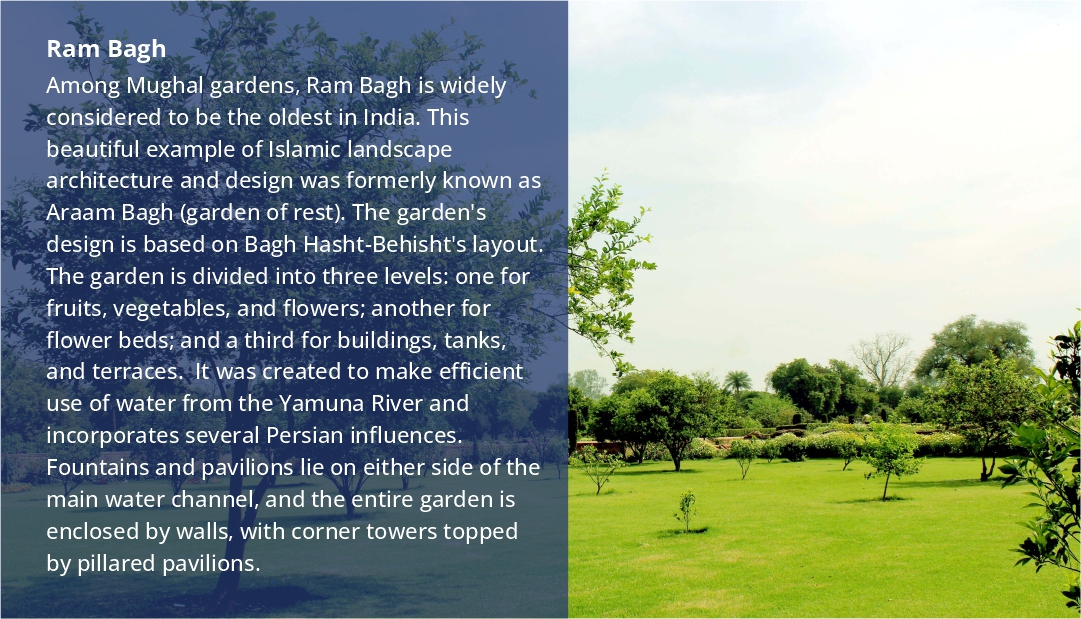
Mehtab Bagh
On the western bank of the River Yamuna, this lovely garden can be found in perfect alignment with the Taj Mahal’s gardens, which are situated across the water. Several fascinating excavations have been conducted across 300 square metres at Mehtab Bagh. It was adorned with walkways, fountains, pavilions, pools, and numerous fruit trees. Therefore, it is assumed that the design was approached almost as if Mehtab Bagh were intended to be an integral part of the Taj Mahal complex, like a riverfront terrace.
On the western bank of the River Yamuna, this lovely garden can be found in perfect alignment with the Taj Mahal’s gardens, which are situated across the water. Several fascinating excavations have been conducted across 300 square metres at Mehtab Bagh. It was adorned with walkways, fountains, pavilions, pools, and numerous fruit trees. Therefore, it is assumed that the design was approached almost as if Mehtab Bagh were intended to be an integral part of the Taj Mahal complex, like a riverfront terrace.
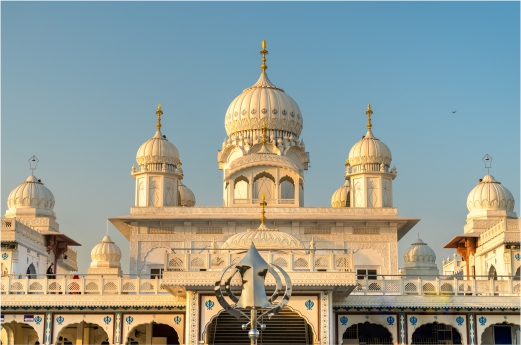
Guru Ka Taal
It is a sprawling premise of a large and attractive Gurudwara. This gurudwara was constructed in 1970 on the site where Sikh guru Tegh Bahadur surrendered his weapons and suggested voluntary arrest to Mughal king Aurangazeb. Historical artefacts and records are seen in the Gurudwara. The place has a pond which was built in 1610. The water from the pond was used for irrigation purposes by the Mughals.
It is a sprawling premise of a large and attractive Gurudwara. This gurudwara was constructed in 1970 on the site where Sikh guru Tegh Bahadur surrendered his weapons and suggested voluntary arrest to Mughal king Aurangazeb. Historical artefacts and records are seen in the Gurudwara. The place has a pond which was built in 1610. The water from the pond was used for irrigation purposes by the Mughals.


-
Destination



